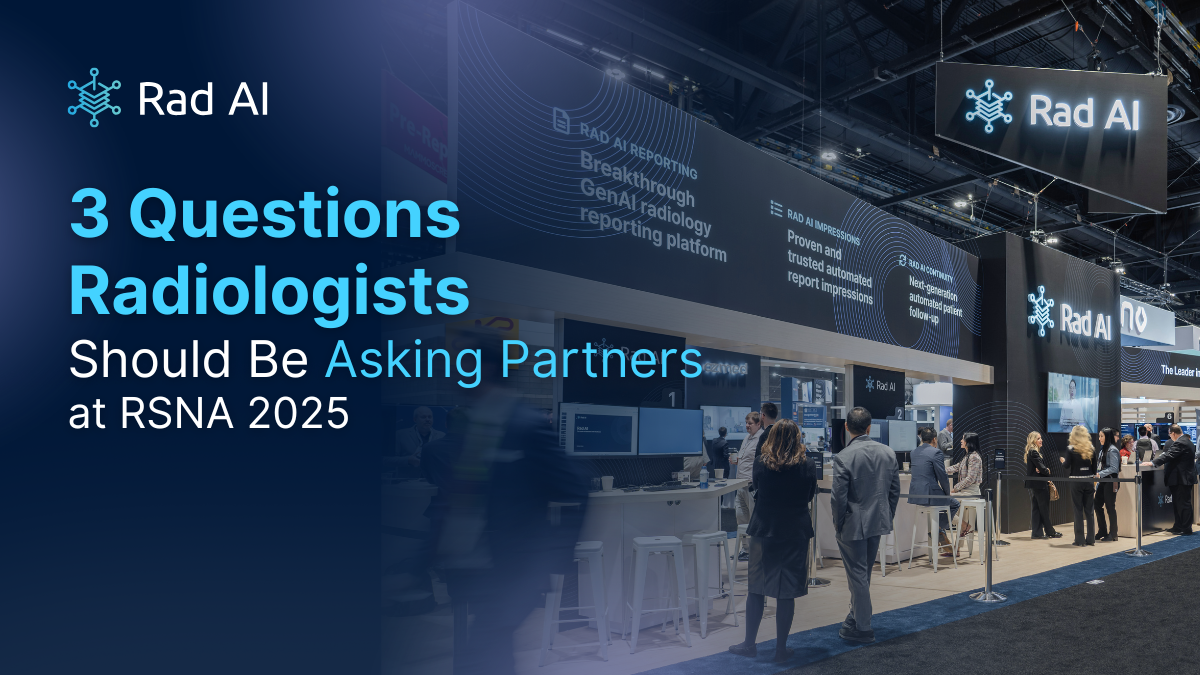3 Questions Radiologists Should Be Asking Potential Partners at RSNA 2025


After reflecting on your organization’s AI readiness, workflow gaps, and success criteria, it’s time for radiology leaders to turn their attention outward, toward the vendors and tools on the RSNA showroom floor.
At RSNA 2025, every vendor will claim their solution is delivering high-caliber results and improving the lives of radiologists and their patients. You’ll hear about autonomous AI agents. You’ll see generative AI transform reporting. You’ll see the latest imaging detection algorithms. But the real challenge for radiology leaders won’t be finding a compelling AI solution – it will be how adeptly they can cut through the noise to find tools that not only deliver measurable value, but can be truly useful for their organization.
Before venturing out into the sea of booths, radiology leaders should come equipped with pointed questions: What’s your adoption rate? What measurable ROI can you demonstrate? Where is your technology implemented today, and how long has it been implemented for?
That’s just the tip of the iceberg. Here are three questions radiology leaders should be asking the potential partners they’ll meet in Chicago later this month.
1. Why this use case, and why this partner?
There will be no shortage of AI solutions on RSNA’s exhibit floor, but not every tool deserves your attention. The strongest partners won’t just deliver accuracy; they’ll align with your organizational mission, clinicians, and standards of care.
Ask vendors what sets their solution apart from the herd. Can they show peer-reviewed outcomes or real-world deployments? Do they understand the nuances of radiology, or are they applying a generic AI model to a complex specialty?
The best partners will be able to prove their technology enhances trust and efficiency.
2. How will this solution integrate with how we actually work?
Implementation should feel like progress, not disruption. Before you consider a pilot, ask how the solution will fit into your existing tech stack and day-to-day operations. Does it integrate directly with your reporting platform, or will it require additional toggling between windows and screens?
AI tools for radiologists can only work when radiologists feel it was designed for them, not imposed on them. The goal isn’t to add another layer of complexity to radiologists’ workflow, but to help them focus on what they do best: synthesize findings and improve patient care.
3. What happens after go-live?
Every demo looks flawless under perfectly controlled conditions, but what happens six months after implementation? The real test is continuous evaluation and oversight.
Ask vendors how they measure ongoing performance, user satisfaction and engagement, and ROI over time. What’s their process for collecting radiologists’ feedback look like? How are they evolving based on that data?
There is no place for the “set it and forget it” approach in healthcare. Responsible AI adoption requires ongoing collaboration, measurement, and iteration to stay effective and safe. You deserve the assurance of knowing that the models your radiologists rely on are adapting as your practice evolves.
Rad AI at RSNA
Radiology is the backbone of modern medicine. Now, it’s becoming AI’s proving ground in healthcare. The organizations that lead will be those that approach AI adoption as an ongoing journey and choose partners that share their commitment to that strategy.
If you’re heading to RSNA, we’d love to connect. Book a meeting with Rad AI to see how we’re helping radiologists bring their expertise out of the darkness and into the light.





